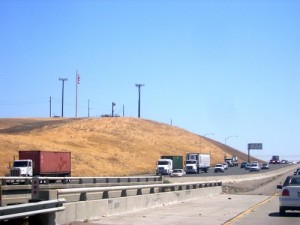
In the 1990’s, a study presented to the Stanislaus Council of Governments (STANCOG) predicted that by 2050, the Altamont Pass would need a freeway with 17 lanes to serve the connection between the San Joaquin Valley and the Bay Area. The study concluded that Alameda County would be the gatekeeper of San Joaquin Valley economic growth, in part because the Coast Range provides a natural barrier between the sprawling Bay Area and the Central Valley. Alameda County controls all the roads that connect the Bay Area and Stanislaus and San Joaquin Counties.
The Del Puerto Canyon/Mount Hamilton Road is a tortuous 2 hour winding drive that connects western Stanislaus County to San Jose. No sane driver would use the road on a regular basis. Former Tracy Congressman Richard Pombo proposed building a multi-billion dollar freeway along the corridor while he held office. Few took his proposal seriously because of the cost.
The 1990’s study was discussed by a Citizens Advisory Committee. During a consultant’s presentation, Alameda County was referred to as “the Gatekeeper.” The term referred to Alameda’s control of any road widening in the mountains between the Central Valley and the Bay Area. Interstate 580 is the only freeway and primary connector between Livermore and Tracy. If the Gatekeeper decides not to allow the interstate to be widened, economic growth in the Valley could be hampered by the inability of commerce to move smoothly through the mountains.
Keeping the Gate Small
As with all political jurisdictions, Alameda County operates its government primarily for the benefit of its citizens. The county doesn’t care much whether the Central Valley lives or dies economically.
Alameda County has little incentive to improve Interstate 580 between Greenville Road in the Livermore Valley and the eastern boundary near the Interstate 205 interchange because very few people live there. Hence, any improvement of the section of I-580 through the mountains is at the bottom of Alameda County’s priority list.
Conversely, the Central Valley desperately needs a smooth flowing I-580 through the mountains in order to get goods and commuters to markets and jobs. Thus, Alameda County controls Central Valley access to the Bay Area and has the ability to facilitate or choke traffic through the corridor.
A Giant Parking Lot
Anyone who has ever driven over the Altamont Pass during rush hour realizes how narrow the gate is. Stop and go traffic is chronic during peak hours. Frequent accidents add to commute times. Since the local economy has improved, Interstate 580 often looks like a giant parking lot. It can be congested any time of the day.
Alameda County is presently widening Interstate 580 between the summit of Altamont Pass and Interstate 680 on the west side of the Livermore Valley. The widening will alleviate congestion in Alameda County, but less relief will be granted to citizens of the Central Valley who use the route.
One mile east of the Altamont summit, the Interstate 580 will narrow from five lanes to four. Any lane constriction during rush hour may cause major delays. Alameda County might not choose to widen the road to its eastern boundary unless traffic jams back up cars all the way into the Livermore Valley. The freeway widening will simply push the traffic jams eastward and only inconvenience Central Valley residents or others headed out of Alameda County.
Perpetual Construction
Leaders in the Central Valley want the local economy to grow. They have no intention of limiting urban growth or controlling the population. Growth is seen as good for the bottom line.
Alameda County doesn’t care whether the Central Valley grows because the county does not see much benefit in accommodating the Valley. The Central Valley is a nuisance because commuters clog roadways. The different interests mean that the Central Valley is limited by Alameda County’s willingness to accommodate the Valley’s need for more lanes on Interstate 580.
Given the projected need of 17 freeway lanes through the Altamont Pass by 2050, the roadway will need to be under perpetual construction. Since the roadway east of the summit hasn’t even been repaved in over 30 years and has potholes and other damage as bad as a third world highway, how likely is it that Alameda will be cooperative?
Stanislaus and San Joaquin Counties have been building freeways and expressways profusely in the past decade. The two counties appear to think that the population and local economy will be surging. Given the limitations of the 580 corridor, the Valley may be overly optimistic about its prospects.
